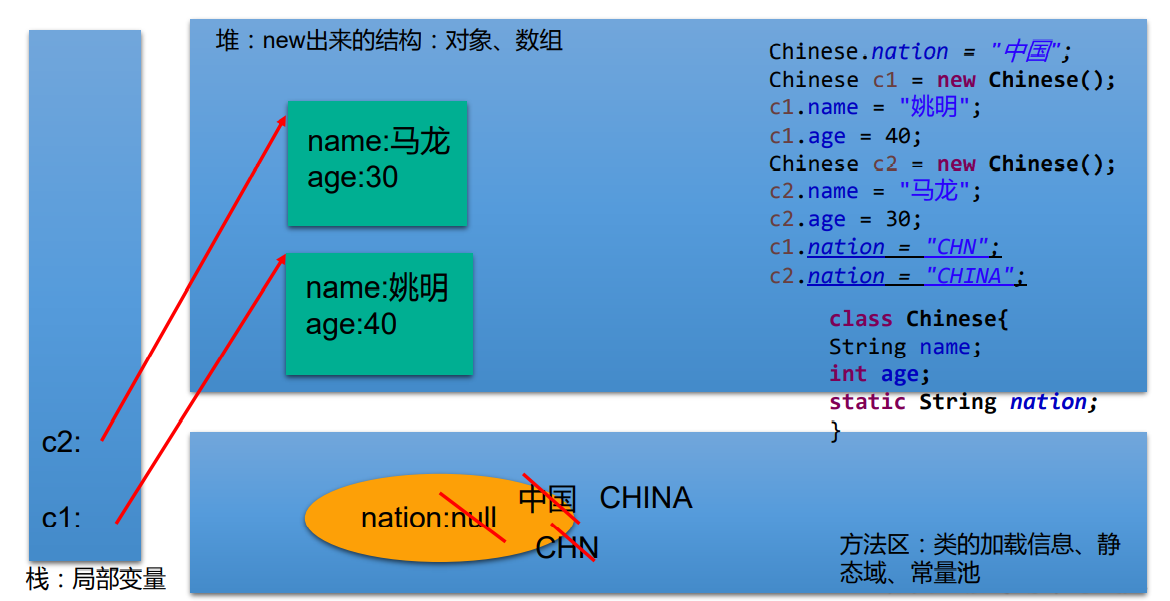static关键字的使用 1.static:静态的
3.使用static修饰属性:静态变量(或类变量)
④ 类变量 实例变量
类 yes no
对象 yes yes
3.3 静态属性举例:System.out; Math.PI;
4.使用static修饰方法:静态方法
static注意点:
开发中,如何确定一个属性是否要声明为static的?
> 属性是可以被多个对象所共享的,不会随着对象的不同而不同的。
> 类中的常量也常常声明为static
开发中,如何确定一个方法是否要声明为static的?
> 操作静态属性的方法,通常设置为static的
> 工具类中的方法,习惯上声明为static的。 比如:Math、Arrays、Collections
类变量和实例变量的内存解析:
例子: 1 2 3 4 5 6 7 8 9 10 11 12 13 14 15 16 17 18 19 20 21 22 23 24 25 26 27 28 29 30 31 32 33 34 35 36 37 38 39 40 41 42 43 44 45 46 47 48 49 50 51 52 53 54 55 56 57 58 59 60 61 62 63 64 65 66 public class StaticTest public static void main (String[] args) Chinese.nation = "中国" ; Chinese c1 = new Chinese(); c1.name = "姚明" ; c1.age = 40 ; c1.nation = "CHN" ; Chinese c2 = new Chinese(); c2.name = "马龙" ; c2.age = 30 ; c2.nation = "CHINA" ; System.out.println(c1.nation); c1.eat(); Chinese.show(); } } class Chinese String name; int age; static String nation; public void eat () System.out.println("中国人吃中餐" ); this .info(); System.out.println("name :" +name); walk(); System.out.println("nation : " + nation); } public static void show () System.out.println("我是一个中国人!" ); System.out.println(Chinese.nation); walk(); } public void info () System.out.println("name :" + name +",age : " + age); } public static void walk () } }
Demo: 1 2 3 4 5 6 7 8 9 10 11 12 13 14 15 16 17 18 19 20 21 22 23 24 25 26 27 28 29 30 31 32 33 34 35 36 37 38 39 40 41 42 43 44 45 46 47 48 49 50 51 52 53 54 55 56 57 58 59 60 61 public class CircleTest public static void main (String[] args) Circle c1 = new Circle(); Circle c2 = new Circle(); Circle c3 = new Circle(3.4 ); System.out.println("c1的id:" + c1.getId() ); System.out.println("c2的id:" + c2.getId() ); System.out.println("c3的id:" + c3.getId() ); System.out.println("创建的圆的个数为:" + Circle.getTotal()); } } class Circle private double radius; private int id; public Circle () id = init++; total++; } public Circle (double radius) this (); this .radius = radius; } private static int total; private static int init = 1001 ; public double findArea () return 3.14 * radius * radius; } public double getRadius () return radius; } public void setRadius (double radius) this .radius = radius; } public int getId () return id; } public static int getTotal () return total; } }


